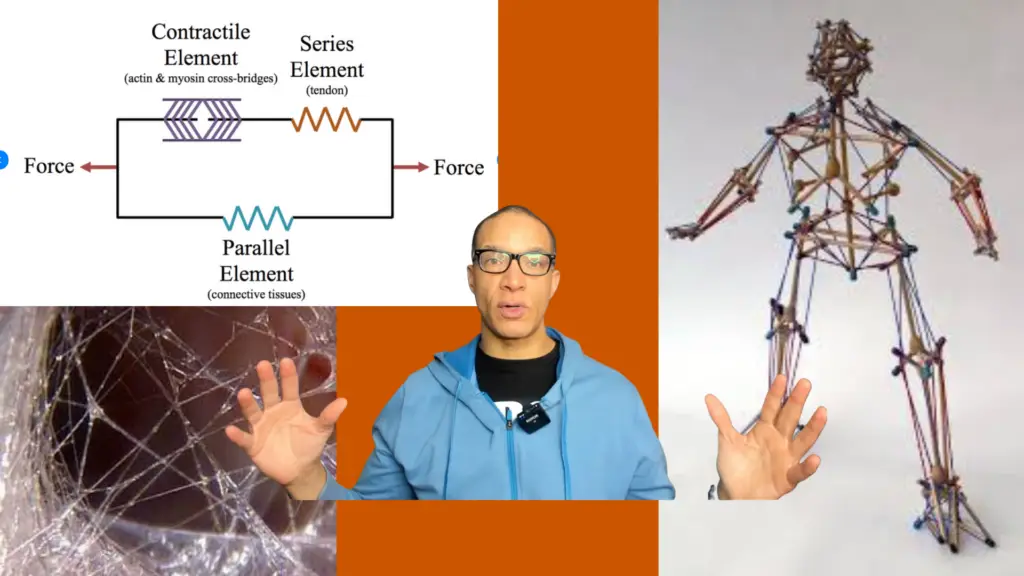
This is very unfortunate. 🤦🏾
Beware the information you take in on social media and the interweb (yes, I know the irony here). I recently saw a post from a “trainer” I know is new to the profession — not certified, and barely trained — claiming boldly that you don’t need to stretch.
Ummmm… no.
Science says yes, and for multiple important reasons. Let’s break this down so it’s not just a rant — but a chance to learn.
1. The Hill Muscle Model
First, there’s the Hill Muscle Model, a foundational concept in muscle physiology. It explains that muscles behave like a system of contractile and elastic components — meaning they can both shorten and stretch.
If you ignore the elastic part of this model (the part that allows muscles to lengthen and absorb force), you’re essentially forcing your body to operate with only half the system functional. That’s a recipe for strain and injury.
2. Biotensegrity and Structural Balance
Your body isn’t a stack of bones held together with tape. It’s a dynamic, balanced system governed by biotensegrity — a term describing how tension and compression work together to create stability and fluid movement.
Think of it like a geodesic dome: it’s not rigid, but it’s strong. Your fascia, ligaments, and muscles maintain that tension network. When one part becomes too tight or too loose, the entire structure compensates — often in inefficient or painful ways. Stretching, when done appropriately, keeps this system balanced.
3. Fascia Health and Soft Tissue Quality
Your fascia — the connective tissue that wraps around muscles, organs, and joints — needs to be pliable and hydrated to function well. Without stretching, the fascia becomes stiff, dehydrated, and restrictive. This limits range of motion and increases the risk of injury.
Stretching nourishes and rehydrates the fascia. It improves sliding surfaces between tissues and reduces unnecessary friction that contributes to chronic pain or dysfunction.
4. Functional Range of Motion (ROM)
Your joints and muscles are meant to move through a full range of motion. But if your body doesn’t experience that range regularly, it adapts by shrinking your capabilities.
Imagine owning a sports car but only ever driving it in first gear. That’s what happens when you skip mobility work and stretching — your joints and soft tissues lose their full capacity. Eventually, simple movements like bending, twisting, or reaching become harder, more painful, or even dangerous.
5. The Consequences of Misinformation
Here’s the real danger: the trainer who said “you don’t need to stretch” isn’t evil — they’re just inexperienced and unaware. The bigger issue is that people hear statements like that and believe them. And then they suffer.
Social media has made everyone feel like an expert. But true expertise doesn’t just come from reading a few studies or copying flashy workouts. It comes from years of study, experience, reflection, and humility — especially humility to know how much you don’t know.
6. The Pieced-Together Workout Problem
This is how we end up with Frankenstein “total body workouts” built on partial facts. The logic seems sound on the surface: if I work all my muscles, I’m doing a total-body workout. But unless that workout respects the body’s complex interconnections, neurological readiness, structural imbalances, and fascial tension — it’s not actually holistic. It’s just random movement with good intentions.
And unfortunately, good intentions don’t protect your joints, restore your balance, or make you move better. Thoughtful, informed planning does.
What You Can Do Instead
Instead of chasing conflicting advice online, study with purpose. Take in complete models that respect the body’s design — not just cherry-picked hacks that sound good in a 60-second video.
If you want to start learning what works, I wrote an ebook that distills insights from almost 30 years of work in therapy and training. It’s a great place to begin if your goals include:
- Longevity
- Functional strength
- Real mobility
- Relief from back, SI joint, or muscle pain
You can grab the ebook with the link below.
Move better. Reduce pain. Live life on your terms.
Let’s be better than social media noise. Let’s stretch — intelligently, consistently, and with an understanding of why stretching matters.
Building a foundation for a better life.
Find out more @

Leave a Reply